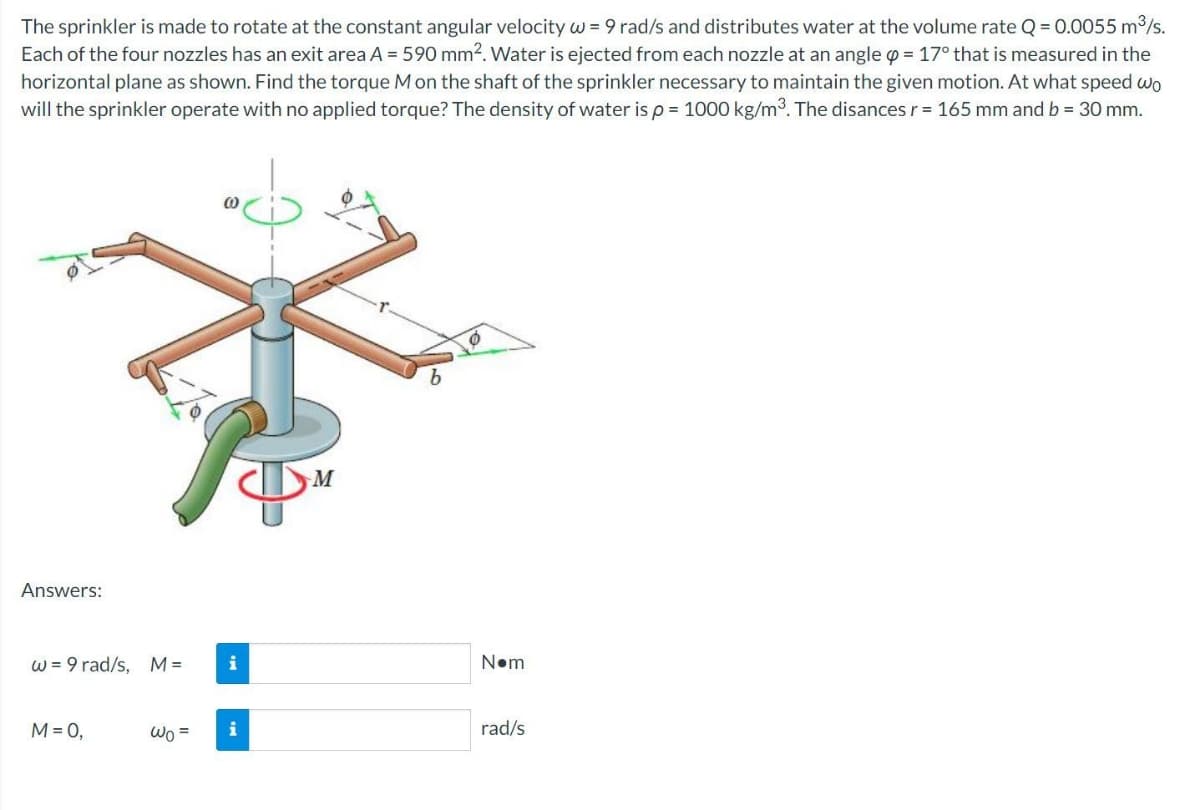The sprinkler is made to rotate at the constant angular velocity w = 9 rad/s and distributes water at the volume rate Q = 0.0055 m3/s. Each of the four nozzles has an exit area A = 590 mm2. Water is ejected from each nozzle at an angle o = 17° that is measured in the horizontal plane as shown. Find the torque M on the shaft of the sprinkler necessary to maintain the given motion. At what speed wo will the sprinkler operate with no applied torque? The density of water is p = 1000 kg/m3. The disances r= 165 mm and b = 30 mm.
The sprinkler is made to rotate at the constant angular velocity w = 9 rad/s and distributes water at the volume rate Q = 0.0055 m3/s. Each of the four nozzles has an exit area A = 590 mm2. Water is ejected from each nozzle at an angle o = 17° that is measured in the horizontal plane as shown. Find the torque M on the shaft of the sprinkler necessary to maintain the given motion. At what speed wo will the sprinkler operate with no applied torque? The density of water is p = 1000 kg/m3. The disances r= 165 mm and b = 30 mm.
Elements Of Electromagnetics
7th Edition
ISBN:9780190698614
Author:Sadiku, Matthew N. O.
Publisher:Sadiku, Matthew N. O.
ChapterMA: Math Assessment
Section: Chapter Questions
Problem 1.1MA
Related questions
Question
8

Transcribed Image Text:The sprinkler is made to rotate at the constant angular velocity w = 9 rad/s and distributes water at the volume rate Q = 0.0055 m³/s.
Each of the four nozzles has an exit area A = 590 mm². Water is ejected from each nozzle at an angle = 17° that is measured in the
horizontal plane as shown. Find the torque M on the shaft of the sprinkler necessary to maintain the given motion. At what speed wo
will the sprinkler operate with no applied torque? The density of water is p = 1000 kg/m³. The disances r = 165 mm and b = 30 mm.
(0
Ø
Answers:
w = 9 rad/s, M=
M = 0,
Wo=
i
M
b
N•m
rad/s
Expert Solution
This question has been solved!
Explore an expertly crafted, step-by-step solution for a thorough understanding of key concepts.
Step by step
Solved in 4 steps with 4 images

Knowledge Booster
Learn more about
Need a deep-dive on the concept behind this application? Look no further. Learn more about this topic, mechanical-engineering and related others by exploring similar questions and additional content below.Recommended textbooks for you

Elements Of Electromagnetics
Mechanical Engineering
ISBN:
9780190698614
Author:
Sadiku, Matthew N. O.
Publisher:
Oxford University Press

Mechanics of Materials (10th Edition)
Mechanical Engineering
ISBN:
9780134319650
Author:
Russell C. Hibbeler
Publisher:
PEARSON

Thermodynamics: An Engineering Approach
Mechanical Engineering
ISBN:
9781259822674
Author:
Yunus A. Cengel Dr., Michael A. Boles
Publisher:
McGraw-Hill Education

Elements Of Electromagnetics
Mechanical Engineering
ISBN:
9780190698614
Author:
Sadiku, Matthew N. O.
Publisher:
Oxford University Press

Mechanics of Materials (10th Edition)
Mechanical Engineering
ISBN:
9780134319650
Author:
Russell C. Hibbeler
Publisher:
PEARSON

Thermodynamics: An Engineering Approach
Mechanical Engineering
ISBN:
9781259822674
Author:
Yunus A. Cengel Dr., Michael A. Boles
Publisher:
McGraw-Hill Education

Control Systems Engineering
Mechanical Engineering
ISBN:
9781118170519
Author:
Norman S. Nise
Publisher:
WILEY

Mechanics of Materials (MindTap Course List)
Mechanical Engineering
ISBN:
9781337093347
Author:
Barry J. Goodno, James M. Gere
Publisher:
Cengage Learning

Engineering Mechanics: Statics
Mechanical Engineering
ISBN:
9781118807330
Author:
James L. Meriam, L. G. Kraige, J. N. Bolton
Publisher:
WILEY